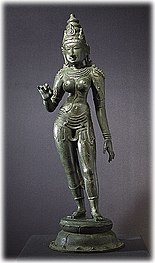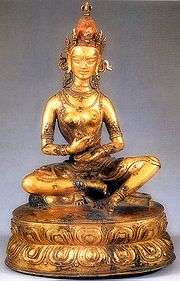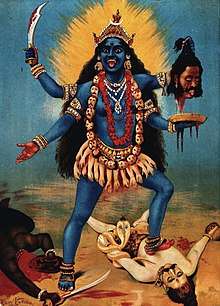Yogini
Yogini (sometimes spelled jogan) is a Sanskrit term for a female master practitioner of yoga, as well as a formal term of respect for female Hindu or Buddhist spiritual teachers in Indian subcontinent, Southeast Asia and Greater Tibet. The term is the feminine Sanskrit word of the masculine yogi, while the term "yogin" IPA: [ˈjoːɡɪn] is used in neutral, masculine or feminine sense.[1]
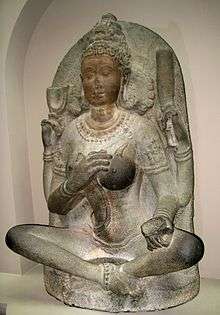
A Yogini, in some contexts, is the sacred feminine force made incarnate, as an aspect of Parvati, and revered in yogini temples of India as the Eight Matrikas or the Sixty-four Yoginis.[2][3]
In Hinduism, yoginis are women in the Yoga school or in the Gorakshanath-founded Nath Yogi tradition.[4] Women in tantra traditions, whether Hindu or Buddhist, are also called yoginis.[5][6] In Tantric Buddhism, Miranda Shaw states that many women like Dombiyogini, Sahajayogicinta, Lakshminkara, Mekhala, Kankhala Gangadhara, Siddharajni, and others, were respected yoginis and advanced seekers on the path to enlightenment.[7]
Yogini in history
Yogini (jogan) is a term in ancient and medieval texts in Hinduism, Buddhism and Jainism, typically in the context of and as aspect of Devi. The Devi Sukta of the Rigveda 10.125.1 through 10.125.8, is among the most studied hymns declaring that the ultimate metaphysical reality (Brahman) is a Devi,[8][9]
I have created all worlds at my will, without being urged by any higher being, and I dwell within them.
I permeate the earth and heaven, all created entities with my greatness, and dwell in them as eternal and infinite consciousness.
The Vedas include numerous goddesses including Ushas (dawn), Prithvi (earth), Aditi (cosmic moral order), Saraswati (river, knowledge), Vāc (sound), Nirṛti (destruction), Ratri (night), Aranyani (forest), and bounty goddesses such as Dinsana, Raka, Puramdhi, Parendi, Bharati, and Mahi among others are mentioned in the Rigveda.[11] However, the women are not discussed as frequently as men.[11] All gods and goddesses are distinguished in the Vedic times,[12] but in the post-Vedic texts, particularly in the early medieval era literature, they are ultimately seen as aspects or manifestations of one Universal Absolute, the Supreme power, Para Brahman.[13]
The earliest evidence of Yogis and their spiritual tradition, states Karel Werner, is found in the Keśin Hymn of the Vedas, where these yogins are praised.[14] However, there is no mention that these Vedic era Yogis included women. Scholars note that some ancient Vedic sages (rishis) were women.[15][16] A female rishi is known as a rishika.[17]
The term yogini has been in use in medieval times to refer to a woman who belongs to the Gorakshanath-founded Nath Yogi tradition.[18] They usually belong to Shaiva tradition, but some Natha belong to the Vaishnava tradition.[19] In both cases, states David Lorenzen, they practice Yoga and their principal God tends to be Nirguna, that is a God that is without form and semi-monistic,[19] influenced in the medieval era by the Advaita Vedanta school of Hinduism, Madhyamaka school of Buddhism, as well as Tantra and Yogic practices.[20][21] Female yoginis were a large part of this tradition, and many 2nd-millennium paintings depict them and their Yoga practices. David Lorenzen states that the Nath yogis have been very popular with the rural population in South Asia, with medieval era tales and stories about Nath yogis continuing to be remembered in contemporary times, in the Deccan, western and northern states of India and in Nepal.[19]
In medieval mythology such as Kathāsaritsāgara, yogini is also the name of a class of females with magical powers, fairies who are sorceresses sometimes enumerated as 8, 60, 64 or 65.[22] The Hatha-Yoga-Pradipika text mentions Yogini.[23]
In real life, historical evidence on Yogini Kaulas suggests that the yogini tradition in Hinduism, involving the practice of Yoga philosophy and Tantra, was well established by the 10th century.[24] This development was not limited to Hinduism, and was practised also in Buddhist tantra traditions.[24]
Yoginis in Shaktism and Tantrika
Temples to the Sixty-four Yoginis
There are four major extant shrines of the Sixty-four Yoginis (Chausathi Jogan) in India, two in Odisha and two in Madhya Pradesh. One of the temples in Odisha is the ninth century CE hypaethral Chausathi Jogini Temple, Hirapur in Khurda district, 15 km south of Bhubaneshwar. Another hypaethral sixty-four yogini temple in Odisha is the Chausathi Yogini Pitha in Ranipur-Jharial, near Titilagarh in Balangir district. Two images of the Sixty-four Yogini are missing from this temple.[25]
Two notable yogini temples in Madhya Pradesh are the ninth-century Chaunsath Yogini Temple to the southwest of the western group of temples in Khajuraho, near Chhatarpur in Chhatarpur District, and the 10th century CE Chaunsath Yogini Mandir in Bhedaghat, near Jabalpur in Jabalpur district.[26][27]
The iconographies of the yogini statues in the four yogini temples are not uniform, nor are the yoginis the same in each set of 64. In the Hirapur temple, all the yoginis are depicted with their Vahanas (animal vehicles) and in standing posture. In the Ranipur-Jharial temple the yogini images are in dancing posture. In the Bhedaghat temple, the yoginis are seated in lalitasana.[28]
The sixty-four yoginis in the complete Hirapur shrine are:
- Bahurupa
- Tara
- Narmada
- Yamuna
- Shanti
- Varuni
- Kshemankari
- Aindri
- Varahi
- Ranveera
- Vanara-Mukhi
- Vaishnavi
- Kalaratri
- Vaidyaroopa
- Charchika
- Betali
- Chinnamastika
- Vrishabahana
- Jwala Kamini
- Ghatavara
- Karakali
- Saraswati
- Birupa
- Kauveri
- Bhaluka
- Narasimhi
- Biraja
- Vikatanna
- Mahalakshmi
- Kaumari
- Maha Maya
- Rati
- Karkari
- Sarpashya
- Yakshini
- Vinayaki
- Vindya Balini
- Veera Kumari
- Maheshwari
- Ambika
- Kamiyani
- Ghatabari
- Stutee
- Kali
- Uma
- Narayani
- Samudraa
- Brahmani
- Jwala Mukhi
- Agneyei
- Aditi
- Chandrakanti
- Vayubega
- Chamunda
- Murati
- Ganga
- Dhumavati
- Gandhari
- Sarva Mangala
- Ajita
- Surya Putri
- Vayu Veena
- Aghora
- Bhadrakali
- Chausathi Jogini Temple, Hirapur, Odisha, 2012. The yoginis have recently been venerated with the gift of headscarves.
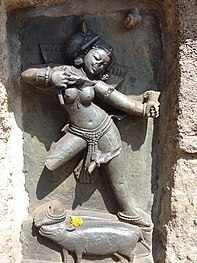 One of the Yogini of Chausathi Jogini Temple at Hirapur, Odisha. There is an offering of flowers at the yogini's feet.
One of the Yogini of Chausathi Jogini Temple at Hirapur, Odisha. There is an offering of flowers at the yogini's feet..jpg) 8th-century Chausath Yogini Temple, Morena, Madhya Pradesh
8th-century Chausath Yogini Temple, Morena, Madhya Pradesh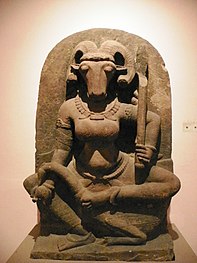 Yogini Vrishanana, 10th-11th c. AD
Yogini Vrishanana, 10th-11th c. AD
Association with Matrikas
The Matrikas are often confused with the legendary yoginis, who may number sixty-four or eighty-one.[29] In Sanskrit literature, the yoginis have been represented as the attendants or various manifestations of Durga engaged in fighting with the demons Shumbha and Nishumbha, and the principal yoginis are identified with the Matrikas.[30] Other yoginis are described as born from one or more Matrikas. The derivation of 64 yogini from eight Matrikas became a tradition. By mid-11th century, the connection between yoginis and Matrikas had become common lore. The mandala (circle) and chakra of yoginis were used alternatively. The 81 yoginis evolve from a group of nine Matrikas, instead of eight. The Saptamatrika (Brahmi, Maheshvari, Kaumari, Vaishnavi, Varahi, Indrani (Aindri) and Chamundi) joined by Candika and Mahalakshmi form the nine-Matrika cluster. Each Matrika is considered to be a yogini and is associate with eight other yoginis resulting in the troupe of 81 (nine times nine).[31] Some traditions have only seven Matrikas, and thus fewer yoginis.
In modern yoga
Pioneering female teachers of modern yoga as exercise are sometimes described as yoginis; for example, Janice Gates, in her 2006 book Yogini, describes the contributions of Nischala Joy Devi, Donna Farhi, Angela Farmer, Lilias Folan, Sharon Gannon (co-founder of Jivamukti Yoga), Sally Kempton, Gurmukh Kaur Khalsa, Judith Hanson Lasater, Swamini Mayatitananda, Sonia Nelson, Sarah Powers, Shiva Rea, Patricia Sullivan, and Rama Jyoti Vernon.[32]
See also
References
- Monier Monier-Williams, Sanskrit English Dictionary with Etymology, Oxford University Press, योगिन्, Archive: yogini
- Chaudhury, Janmejay. Origin of Tantricism and Sixty-four Yogini Cult in Orissa in Orissa Review, October, 2004 Archived May 25, 2010, at the Wayback Machine
- Bhattacharyya, N. N., History of the Sakta Religion, Munshiram Manoharlal Publishers (New Delhi, 1974, 2d ed. 1996), p. 128.
- White 2012, pp. 8-9, 234-256, 454-467.
- Rita Gross (1993), Buddhism After Patriarchy, SUNY Press, ISBN 978-0791414033, page 87, 85-88
- David Gordon White (2013), Tantra in Practice, Motilal Banarsidass, ISBN 978-8120817784, pages xiii-xv
- Shaw, Miranda. Passionate Enlightenment: Women in Tantric Buddhism, Princeton University Press, 1994
- McDaniel 2004, p. 90.
- Brown 1998, p. 26.
- Sanskrit original see: ऋग्वेद: सूक्तं १०.१२५;
for an alternate English translation, see: The Rig Veda/Mandala 10/Hymn 125 Ralph T.H. Griffith (Translator) - David Kinsley (2005), Hindu Goddesses: Vision of the Divine Feminine in the Hindu Religious Traditions, University of California Press, ISBN 978-8120803947, pages 6-17, 55-64
- David Kinsley (2005), Hindu Goddesses: Vision of the Divine Feminine in the Hindu Religious Traditions, University of California Press, ISBN 978-8120803947, pages 18, 19
- Christopher John Fuller (2004), The Camphor Flame: Popular Hinduism and Society in India, Princeton University Press, ISBN 978-0691120485, page 41
- Karel Werner (1977), Yoga and the Ṛg Veda: An Interpretation of the Keśin Hymn (RV 10, 136), Religious Studies, Vol. 13, No. 3, page 289. "The Yogis of Vedic times left little evidence of their existence, practices and achievements. And such evidence as has survived in the Vedas is scanty and indirect. Nevertheless, the existence of accomplished Yogis in Vedic times cannot be doubted."
- Swami Vivekananda public lecture, Vedanta Voice of Freedom, ISBN 0-916356-63-9, p.43
- Daughters of the Goddess: Women Saints of India, by Linda Johnsen, Yes International Publishers, 1994, pg. 9.
- The Shambhala Encyclopedia of Yoga, p.244
- White 2012, p. 8-9.
- David N. Lorenzen and Adrián Muñoz (2012), Yogi Heroes and Poets: Histories and Legends of the Naths, SUNY Press, ISBN 978-1438438900, pages x-xi
- David Lorenzen (2004), Religious Movements in South Asia, 600-1800, Oxford University Press, ISBN 978-0195664485, pages 310-311
- David N. Lorenzen and Adrián Muñoz (2012), Yogi Heroes and Poets: Histories and Legends of the Naths, SUNY Press, ISBN 978-1438438900, pages 24-25
- Monier-Williams, Sanskrit Dictionary (1899).
- The Shambhala Encyclopedia of Yoga, Georg Feuerstein, Shambhala Publications, Boston 2000, p.350
- White 2012, p. 73-75, 132-141.
- Patel, C.B. Monumental Efflorescence of Ranipur-Jharial in Orissa Review, August 2004, pp.41-44 Archived September 30, 2007, at the Wayback Machine
- Jabalpur district official website – about us Archived August 14, 2007, at the Wayback Machine
- Chausath Yogini Temple - Site Plan, Photos and Inventory of Goddesses Archived April 17, 2010, at the Wayback Machine
- Chaudhury, Janmejay. Origin of Tantricism and Sixty-Four Yogini Cult in Orissa in Orissa Review, October 2004 Archived May 25, 2010, at the Wayback Machine
- Dehejia, Vidya, Yogini Cult and Temples
- Bhattacharyya, N. N., History of the Sakta Religion, Munshiram Manoharlal Publishers Pvt. Ltd. (New Delhi, 1974, 2d ed. 1996), p. 128.
- Wangu p.114
- Gates 2006, pp. whole book (a chapter to each of these women).
Bibliography
- Brown, Cheever Mackenzie (1998). The Devi Gita: The Song of the Goddess: A Translation, Annotation, and Commentary. SUNY Press. ISBN 978-0-7914-3939-5.CS1 maint: ref=harv (link)
- Chopra, Shambhavi. Yogini: The Enlightened Woman, Wisdom Tree Press, India, 2006
- Dehejia, Vidya. Yogini Cult and Temples: A Tantric Tradition, National Museum, New Delhi, 1986.
- Feuerstein, Georg. The Shambhala Encyclopedia of Yoga, Shambhala Publications, Boston, 2000
- Gates, Janice (2006). Yogini: Women Visionaries of the Yoga World. Mandala. ISBN 978-1932771886.CS1 maint: ref=harv (link)
- Gupta, Roxanne Kamayani. A Yoga of Indian Classical Dance: The Yogini's Mirror, Inner Traditions, U.S., 2000
- Johnsen, Linda. "Daughters of the Goddess: The Women Saints of India", Yes Int'l Publishing, U.S., 1994
- McDaniel, June (2004). Offering Flowers, Feeding Skulls : Popular Goddess Worship in West Bengal: Popular Goddess Worship in West Bengal. Oxford University Press, USA. ISBN 978-0-19-534713-5.CS1 maint: ref=harv (link)
- Parvati Baker, Jeannine. Prenatal Yoga & Natural Childbirth, North Atlantic Books, 3rd edition, 2001
- Muktananda, Swami. Nawa Yogini Tantra: Yoga for Women, Yoga Publications Trust, Bihar, 2004
- Shaw, Miranda. Passionate Enlightenment: Women in Tantric Buddhism, Princeton University Press, 1994
- Shaw, Miranda. Buddhist Goddesses of India, Princeton University Press, 2006.
- Tiwari, Bri. Maya. The Path of Practice: A Woman's Book of Ayurvedic Healing, Motilal Banarsidass Press, 2002
- Wangu, Madhu Bazaz. Images of Indian Goddesses, Abhinav Publications, New Delhi, 2003
- White, David Gordon (2012). The Alchemical Body: Siddha Traditions in Medieval India. University of Chicago Press. ISBN 9780226149349.CS1 maint: ref=harv (link)
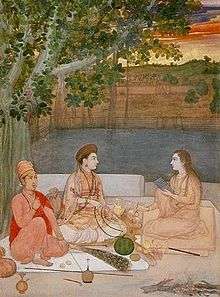
_LACMA_M.2011.156.4_(1_of_2).jpg)
